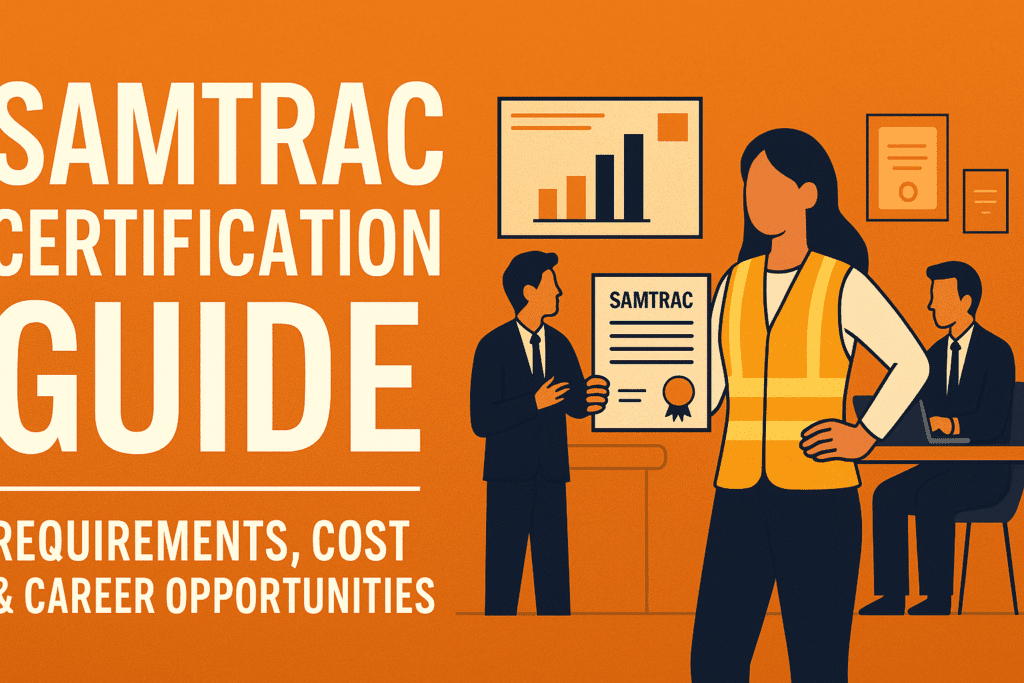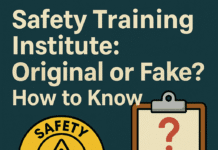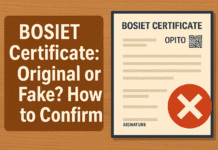
SAMTRAC Certification Guide: Requirements, Cost & Career Opportunities
Introduction
If you’re considering a career in occupational health and safety (OHS), you’ve likely come across the term SAMTRAC. But what is it exactly? And why is it such a big deal in the safety world?
SAMTRAC stands for Safety Management Training Course and is one of the most recognized certifications in South Africa and several other parts of the world. It’s designed to equip professionals with the knowledge and skills needed to manage safety, health, and environmental issues in the workplace.
Let’s break down everything you need to know about the SAMTRAC Certification — from requirements and cost to the career doors it can open for you.
Overview of SAMTRAC Certification
Full Form and Origin
SAMTRAC stands for Safety Management Training Course and was originally developed in South Africa. It’s provided by NOSA (National Occupational Safety Association), a leading name in OHS training.
Who Offers SAMTRAC?
SAMTRAC is officially offered by NOSA, but several training partners and affiliated institutes provide training based on the SAMTRAC curriculum.
Global Recognition of SAMTRAC
While SAMTRAC is highly regarded in South Africa, it’s also recognized in countries like the UAE, Qatar, Oman, and India. It’s especially valued in industries like mining, oil & gas, and construction.
Why Choose SAMTRAC Certification?
Relevance in the Safety Industry
SAMTRAC provides a strong foundation in legal compliance, risk management, and environmental awareness — essential for any safety professional.
Practical and Theoretical Training
The course blends real-world scenarios with technical theory. You don’t just study safety—you learn to think like a safety officer.
Industry Preference and Career Boost
Many recruiters prefer SAMTRAC-certified candidates because they come job-ready with the right mindset and tools.
Eligibility Criteria
Before you jump in, let’s see if you’re eligible.
Educational Qualifications
- Matric (High School Diploma) is generally required.
- Some institutes may accept lower qualifications if you’re already working in the industry.
Work Experience
- Not mandatory, but having some workplace exposure helps you understand concepts better.
Age Limit and Language Requirements
- No strict age limit.
- A good grasp of English is important since all course content and exams are in English.
Course Structure and Modules
Overview of the Curriculum
The course is broken into several modules covering various aspects of occupational health and safety.
Duration of the Course
- Full-time: 5–6 weeks
- Part-time or Online: Can take up to 3–6 months
Learning Outcomes
By the end of SAMTRAC, you’ll be able to:
- Conduct risk assessments
- Identify hazards
- Develop safety programs
- Understand compliance laws
Key Modules Covered
Risk Assessment
Learn to identify, evaluate, and control workplace hazards.
Health and Safety Law
Covers South African OH&S legislation and how to apply it.
Environmental Management
Understand how industrial activities impact the environment and how to manage that impact responsibly.
Incident Investigation
Learn how to investigate workplace accidents and recommend corrective actions.
SAMTRAC for International Use
SAMTRAC vs. SAMTRAC International
- SAMTRAC: Focused on South African regulations.
- SAMTRAC International: Focuses on global standards like ISO 45001 and international best practices.
Where Each is Accepted
- SAMTRAC is ideal for work in South Africa and African countries.
- SAMTRAC International is recognized globally, especially in the Middle East and Asia.
How to Apply for SAMTRAC Certification
Registration Process
- Choose a recognized training provider
- Fill out an online or paper application
- Submit necessary documents and pay the fee
Required Documents
- ID or Passport
- Proof of qualification
- Recent photograph
Mode of Study: Online vs In-Class
- In-Class: Instructor-led sessions, ideal for hands-on learners
- Online: Flexible and self-paced
Exam Format and Evaluation
Number of Exams and Structure
- Exams are module-based and usually include multiple-choice questions and case studies.
Passing Criteria
- You need at least 60% to pass most modules.
Reassessment Policy
- You can reattempt failed modules by paying a nominal fee.
Cost of SAMTRAC Certification
Tuition Fees
- South Africa: R15,000 to R20,000
- International: $700 to $1,200 depending on the provider
Additional Costs
- Study materials
- Exam retakes
- VAT and registration fees
Payment Options
- Upfront or in installments
- Some companies sponsor employees
Online Learning Options
Self-Paced Modules
Ideal if you’re working full-time or prefer flexible schedules.
Instructor-Led Training
Live sessions via Zoom or Teams for a more interactive learning experience.
E-learning Platforms
Some platforms offer recorded lectures and quizzes to test your knowledge as you go.
Career Opportunities After SAMTRAC
Job Roles You Can Apply For
- Safety Officer
- SHEQ Officer
- HSE Coordinator
- Environmental Specialist
Industries That Prefer SAMTRAC
- Oil & Gas
- Mining
- Construction
- Manufacturing
Global Job Market Acceptance
Countries in Africa, Middle East, and even parts of Asia actively recruit SAMTRAC-certified professionals.
Salary Expectations
Entry-Level Salaries
- R12,000 to R20,000/month (South Africa)
- $600–$1,000/month (International)
Experienced Professionals
- R30,000+ in SA
- $2,000+ in the Middle East
Salary by Region
- South Africa: R15k – R35k
- UAE: AED 4,000 – 10,000
- Qatar/Kuwait: $1,500 – $3,000
Benefits of Having SAMTRAC Certification
- Improves employability
- Opens doors internationally
- Boosts earning potential
- Gives you professional credibility
- Keeps you updated with global safety standards
Challenges and How to Overcome Them
Course Intensity
SAMTRAC is dense and covers a lot of material. Stay consistent.
Time Management Tips
- Create a study schedule
- Take weekly mock tests
- Join study groups
Study Resources
- SAMTRAC textbooks
- YouTube tutorials
- Practice question banks
To learn more about the SAMTRAC Certification, official course details, registration, and contact information, please visit the official NOSA website:
This site provides up-to-date information on SAMTRAC course formats, schedules, fees, and other health and safety training programs.
Conclusion
If you’re serious about building a career in health and safety, SAMTRAC is a solid stepping stone. It equips you with the tools, knowledge, and credibility to stand out in a competitive job market. Whether you’re new to the field or looking to upskill, this certification is a smart investment in your future.
How to Pass the NEBOSH IGC in Your First Attempt: Study Plan + Resources
Top 5 Certifications Every Safety Engineer Should Have
ISO 45001 vs OHSAS 18001: What’s the Difference?
ISO 45001:2018 Explained: Key Principles and Core Objectives
FAQs
1. Is SAMTRAC better than NEBOSH?
It depends on your location. NEBOSH is globally accepted, while SAMTRAC is stronger in South Africa and nearby regions.
2. Can I do SAMTRAC without experience?
Yes! You don’t need prior work experience to enroll in the SAMTRAC course.
3. How long is the SAMTRAC certificate valid?
SAMTRAC does not expire, but it’s good to stay updated with short refresher courses.
4. Is SAMTRAC recognized in the Middle East?
Yes, especially in the UAE, Qatar, and Saudi Arabia. SAMTRAC International is often preferred.
5. What is the difference between SAMTRAC and SHE REP?
SHE REP is a basic entry-level safety course, while SAMTRAC is more advanced and suitable for supervisory roles.
























